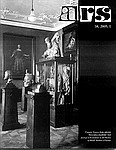
Časopis ARS 38 (2005) 1
Mária ORIŠKOVÁ
Od dejín umenia k vizuálnej kultúre? Príklad Brooklyn Museum of Art v New Yorku[Art History or Visual Culture? A Case Study of Brooklyn Museum of Art in New York]
(Resumé)
In the United States during last two decades heated debates have been turned towards multicultural and intercultural issues. Terms of identity, culture, race, ethnicity or postcolonialism play an important role not only in the traditional art historical discourse but in the art museum, as well. The case study of Brooklyn Museum of Art in New York (within the framework of the exhibition "American Identities: A New Look") is an attempt to discuss the issue of multiculturalism in art museums traditionally based on universalistic (Western) aesthetics. The story of Western art which once was central for the museum is now more complicated by the addition of non-Western art/objects. However, one of the biggest American museums - Brooklyn Museum of Art in New York goes beyond the polarities "high art" vs. "ethnographic object" showing the hybrid culture as the result of colonialism, migration, slavery, diaspora, conflicts or oppression.
Relations between art and ethnicity seem to be one of the main concerns in the museums in multicultural society. Increasing diversity incorporated in art museums raises many questions: the question in the direction of the representability of broader culture in the museum raised in the 1980s by Musée d'Orsay in Paris and the issue of "visual interest" or "visual distinction" of the objects made for attentive looking. Svetlana Alpers in her essay "A Way of Seeing" claims that what museum registers is visual distinction, not necessarily cultural significance. However, anthropologists displaying ethnographic objects with completely different aims consider aesthetic moment without explaining object function not only for insufficient but misleading as well. For anthropologist James Clifford in his essay "Histories of the Tribal and Modern", non-Western objects "generously" included into the context of modern art (next to Picasso or Giacometti) on the base of formal/aesthetic affinities are raised from the position of tribal fetishes or mere ethnographic specimen to the status of high art and appropriated by the modern West "collecting the world".
In the 1980s the aesthetic-anthropological opposition was examined by Susan Vogel, curator of the Center for African Art in New York. In her essay "Always True to the Object, in Our Fashion" Vogel describes her experiments trying to heighten awareness of the degree to which what we see in African art is a reflection of ourselves. The exhibitions "Perspectives: Angles of African Art" and "Art/Artifact" approached the question of the audience (African and non-African) and perception through installation styles (physical setting of an art object called white cube style, Wunderkammer or anthropological diorama). The exhibition stressed that these different styles reflected differences in attitude and interpretation, and that the viewer is manipulated by all of them.
Dismantling "true representations" in the museum opened new issues: the issue of parallelisms and horizontal surveys, both promoted as cultural paradigm by the exhibition "Circa 1492: Art in the Age of Exploration" in the National Gallery in Washington 1992. This concept has been considered controversial by Homi Bhabha. In his essay "Double Visions" Bhabha criticizes parallelism of Western and non-Western art/objects as an illusion of their equality within the modern museum with its homogenizing internationalist mode and turn on an aesthetic axis "of equal distance equal difference". At the individual level, heterogeneity can only be expressive of preexisting differences, as well as the histories of the master come to be reinscribed in terms of, or in contention with, the enslaved or the colonized. Without making such a distinction we can only be connoisseurs and make "global" art more available to the embrace of multicultural aesthetics, secular national present and an international future.
A strange internationalism of museum culture as irrefutable "proof" of neutrality and objectivity of Western museum establishment has been examined by Annie E. Coombes in her essay "Inventing the Postcolonial: Hybridity and Constituency in Contemporary Curating" in the 1990s. Revived anthropological practices as well as the celebration of "difference" are a strategy which according to Coombes could be pernicious when mobilized in the sphere of visual culture in the sites of public consumption. The way in which such "visibility" is mediated by an aesthetic consideration is especially significant in the postcolonial context. Hybridity, the term used by Coombes is articulated as a symptom of what is identified as postcolonial in a sense of the postmodern strategy of bricolage superficially reproducing and celebratory affirming that all are equal. Still, under the cover of celebration (and fast-food like consumption) of differences there is the inequality of access to economic and political power. And only the dominant groups articulate the ways in which such differences are constituted.
English by Mária Orišková